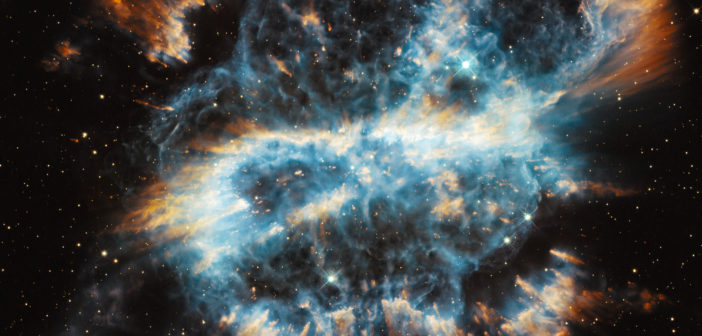Not all laboratory astrophysics occurs in labs down here on Earth; sometimes, the lab is in space! A new study has used a space laboratory to confirm a new atomic process — with far-reaching implications.

The Cat’s Eye planetary nebula, as imaged in X-rays and optical light. [X-ray: NASA/CXC/SAO; Optical: NASA/STScI]
Balancing a Plasma
Throughout our universe, cosmic soups of electrons and ions — astrophysical nebulae — fill the spaces surrounding dying stars, hot and compact binaries, and even supermassive black holes. The atoms in these nebulae cycle within a delicate balance: they are ionized (electrons are torn off) by the high-energy photons emitted from the hot nearby sources, and then they recombine (electrons are recaptured), emitting glowing radiation in the process.
After many years of research into atomic processes, we thought that we’d pretty well pinned down the ways in which this photoionization and recombination takes place. This is crucial, since these rates go into models that we use to determine abundances — which, in turn, informs our understanding of stellar evolution, nucleosynthesis, galactic composition and kinematics, and cosmology.
But what if we’re missing something?
A New Process
In 2010, a team of scientists proposed exactly this: that we’re missing an additional type of recombination process that occurs frequently in astrophysical plasmas throughout the universe.The catch? This type of recombination — which they termed Rydberg Enhanced Recombination, or RER — had never before been detected, and it’s effectively impossible to study in Earth-based laboratories. Only in cold, low-density cosmic environments like astrophysical nebulae do the conditions necessary for RER exist.
Laboratories in Space
When Earth-based labs fail, it’s time to look to space! A team of scientists led by Ahmad Nemer (Auburn University; Princeton University) recently went on the hunt for astrophysical laboratories showing evidence of RER.
First, Nemer and collaborators developed detailed models of how RER would work, under what conditions it would be effective, and what observable spectral lines this process would produce.

Illustration of a symbiotic binary system, consisting of a white dwarf and a red giant. [NASA, ESA, and D. Berry (STScI)]
Time for an Update
Space lab success! In eight of the planetary nebulae and one of the symbiotic binaries, the authors found spectral lines that provide evidence of the RER process at work, with relative strengths that agree nicely with predictions.
This confirmation of a predicted new atomic process represents a remarkable discovery with far-reaching implications. Nemer and collaborators show that the addition of RER contributions into our current models of ionization balance makes a significant difference in estimated elemental abundances of astrophysical nebulae — which means we may have a lot of work ahead of us to update our past research!
Thanks to the power of laboratories in space, however, we now have a clearer idea of what we’ve been missing.
Citation
“First Evidence of Enhanced Recombination in Astrophysical Environments and the Implications for Plasma Diagnostics,” A. Nemer et al 2019 ApJL 887 L9. doi:10.3847/2041-8213/ab5954



1 Comment
Pingback: From AAS NOVA: “Confirming New Physics in Space” | sciencesprings